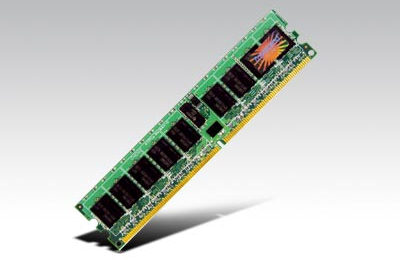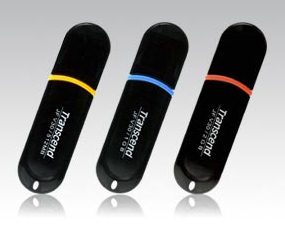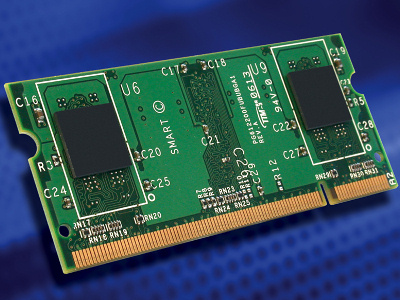 |
||
|
||
| ||
Transcend Releases 1.2" DDR2-667 ECC Modules, JetFlash V30 USB Drives Sony Unveils First Blu-Ray Notebook SMART Modular Introduces First 32-bit 200-pin DDR2 SO-DIMMs Samsung Launches HSDPA Phone in Korea NVIDIA Unveils New Open Standard Memory Specification Transcend Releases 1.2" DDR2-667 ECC Modules, JetFlash V30 USB Drives Transcend Information announced its latest low profile DDR2-667 ECC Registered DIMM memory module (P/N: TS64/128MQR72V6J). 1.2 inches high, these 512MB/1GB modules are for use with high-end servers or computer systems. The six-layer PCB uses 64Mx8 Fine-Pitch Ball Grid Array (FBGA) chip packages for improved electrical and heat dissipation.  Transcend also released its latest addition to the JetFlash V-series -- JetFlash V30 -- with capacities ranging from 512MB to 2GB. Novelties support several proprietary features, including PC-Lock (makes JetFlash V30 a key to lock your computer), Boot-Up (makes JetFlash V30 a bootable device), Partition & Security (ability to create a private partition with password protection).  Source: Transcend Information
Sony Unveils First Blu-Ray Notebook Sony today took the wraps off the world's first Blu-ray Disc enabled notebook computer -- the VAIO AR which will be available this summer. Part of a series, the VAIO AR comes in two different configurations: Premium and Standard. The AR Premium version plays Blu-ray Disc high-definition content, so you can enjoy movies in full 1080p HD resolution. The notebook has a 17-inch WUXGA (1920x1200) widescreen display and uses Sony's XBRITE Hi-Color LCD technology. For those who prefer to watch content on a larger screen, the AR model also has an HDMI connector and included cable that connects to high-definition televisions for a larger viewing experience.  In addition to supporting HD playback, the VAIO AR notebook is able to record high-definition camcorder content to Blu-ray Discs -- all in native 1080 resolution. You can also edit high-definition footage and share it on Sony high-capacity BD-R and BD-RE Blu-ray discs (up to 50 GB) or on traditional DVD-R/RW, DVD+R/+RW media. The AR Premium is available in a high gloss, piano-black finish with silver trim and an illuminated VAIO logo. It also has the latest Intel Centrino Duo mobile technology for processor-heavy multi-tasking and high-definition video editing. The AR will ship with Microsoft Windows Media Center Edition 2005 and includes a built-in standard-definition NTSC TV tuner (select models) and onboard TV controls, so you can watch and record live television. The AR Premium also incorporates an NVIDIA GeForce Go 7600 graphics card featuring 256MB dedicated video memory. The AR series also incorporates a camera and microphone allowing users to chat online with friends and family. The AR Standard model will start at about $1,800, while the AR Premium Blu-ray Disc enabled model will go for about $3,500. The Premium model will be shipped with the Sony Pictures Entertainment Blu-ray Disc release, "House of Flying Daggers,". Source: Sony
SMART Modular Introduces First 32-bit 200-pin DDR2 SO-DIMMs SMART Modular Technologies has launched a new family of DDR2 32-bit 200-pin SO-DIMMs aimed at multi-function printers (MFP) and embedded computing applications. An industry first, SMART's new 32-bit 200-pin SO-DIMMs provide a low-cost, scalable memory solution as an alternative to the traditional method of soldering discrete devices directly to the system board. Offered in densities ranging from 128MB to 512MB, SMARTís new SO-DIMMs can be configured with device bit widths of x8 or x16. System architects can select either type, depending on their processorís functionality and system features sets.  SMART's 32-bit 200-pin SO-DIMM designs are based on Intel's 32-bit SODIMM Addendum to the JEDEC 64-bit SO-DIMM standard specification. They utilize existing JEDEC SO-DIMM standard designs, making it possible for printer and embedded computing applications to use low-cost connectors without the need for re-keying. The JEDEC standard designs have gone through rigorous signal integrity checking and incorporate the same devices that are used in notebook SO-DIMMs. Source: SMART Modular Technologies
Samsung Launches HSDPA Phone in Korea Samsung today launched the high-speed downlink packet access (HSDPA) phone (model: SCH-W200) in Korea. This is the first HSDPA phone commercially available for consumers in the market. Samsung's new slide-up SCH-W200 is able to transmit audio and video data at speeds of 1.8Mbps. It is also the first phone equipped with a 'Dual Band Dual Mode (DBDM)' chip that supports 2G, 3G and 3.5G mobile communication services. It also supports multitasking functions allowing users to receive and send messages during video telephony and while listening to MP3 files.  Users can also enjoy watching mobile TV via Satellite Digital Multimedia Broadcasting (S-DMB) and take pictures with a 2-megapixel camera with auto focus function. It also offers an MP3 player, text-to-speech (TTS) conversion, file viewer and supports a microSD slot. The launch of the Samsung's SCH-W200 marks the world's first commercial HSDPA services in cooperation with SK Telecom, Korea's largest mobile service operator. Samsung will also be providing HSDPA handsets for KTF, Korea's second largest mobile service operator, in June. SCH-W200 specifications:
Source: Samsung
NVIDIA Unveils New Open Standard Memory Specification NVIDIA announced the results of a collaborative memory development effort called Enhanced Performance Profiles, or EPP, which allows consumers to easily expose new, advanced performance memory settings built into high-performance memory DIMMs for even higher levels of overall PC system performance. In addition, NVIDIA also announced that Corsair Memory is the first memory vendor to announce support for the new EPP specification, and is expected to have new EPP-based memory DIMMs available in the channel later this month. Developed as an extension to the traditional Serial Presence Detect (SPD) found on today's high-performance DIMMs, Enhanced Performance Profiles allow memory manufacturers to integrate additional module performance data in the unused portion of the JEDEC standard SPD, allowing compatible motherboards to read and take advantage of added performance capabilities. Enhanced Performance Profiles were developed as an open standard, and immediate adoption is expected shortly from other motherboard partners and PC memory suppliers. While memory modules with Enhanced Performance Profiles will work on any motherboard, only motherboards equipped with specificial BIOSes, such as those designed for NVIDIA nForce 590 SLI MCPs, will detect the presence of these new capabilities and prompt the user to set PC boot parameters for guaranteed optimized settings. End users will be able to measure the impact on benchmark performance and verify detailed parametric settings using common system utilities such as Lavalys EVEREST or NVIDIA nTune. Source: NVIDIA
Write a comment below. No registration needed!
|
Platform · Video · Multimedia · Mobile · Other || About us & Privacy policy · Twitter · Facebook Copyright © Byrds Research & Publishing, Ltd., 1997–2011. All rights reserved. |